Tags
- articles (33)
- bridal (12)
- easy methords (55)
- home treatments (60)
- latest trends (41)
- treatment (59)
- videos (36)
- wallpaper (9)
About Me
- Brijesh Sehgal
- BEAUTY EXPERT (20 YEAR EXPERIENCE) OF RUNNING BEAUTY CLINIC
'Sexy hairstyles:
Thursday, December 31, 2009
Monday, December 21, 2009
Saturday, December 19, 2009
Thursday, August 20, 2009
Beauty Makeup
When you gaze at any beautiful celebrity you want to look like her. It is a natural process of mind through which all of us go. To get a gorgeous look like those celebrities would be miracle for you. You become so surprised how these glamorous women look so stunning! You usually watch them in their reel life which may be different from the real life. But in case of makeup, today reel life and real life are just the same. With good quality of makeup products and some touch of expert hands, you can achieve any aspiring look. Makeup can bring change to your appearance, if you want to get wider, brighter eyes you can have it. Again to get lips with full of volume and shine you have to take the help of good makeup. Choosing a sexy lip color you can create the magic. To cover up all difficulties of the skin you can try concealer or foundation as a face makeup. Thus wide range of option is waiting for you, a little initiative can promote you with attractive beauty and glamor.
Beauty Tips for Models
Have you always dreamt of having a perfect figure, like a model? Are you someone aspiring to get into the world of glitz and fashion? Is being a successful model all that you ever wanted to be? If your answer to all of these is "yes," then collect and keep in mind as many beauty tips for models as possible as these will definitely help you not only when it comes to entering the glam world, but also in keeping your career steady.
There are numerous beauty tips for models available on television programs and in magazines, as well as on internet sites. But if you are still wondering where to look for them, do not bother, simply read on as this page brings to you all the great tips on beauty for models. Read on and transform yourself!
Before we start with our beauty tips for models, we would like to offer a clarification. Models have a rigorous exercise regimen along with a diet regimen. Before you start any exercise or diet regimen, it's always advisable to consult a fitness trainer and a dietitian. Also, consult your doctor before you start off any new exercise.
Facial Beauty Tips for Models
Keeping the face clean is of utmost importance in the world of modeling. A blemish free and acne free face will definitely be most desired as it will always be in focus during photo shoots and ramp modeling and other campaigns. You can get a blemish free face by taking up a regular cleaning, toning and moisturizing routine before going to bed. Also do a facial, or get a facial done twice a week. Applying natural face packs once in 5 days will definitely help. Just ensure that none of the products contain harmful chemicals. The beauty care products should be suited to your skin type. Get your eyebrows shaped at a parlor as the shape of your eyebrows determine your look to a large extent.
Hair Care Tips for Models
Keep your hair clean all through the week. Oiling and shampooing your hair twice a week will do the trick. Every shampoo must be followed by proper conditioning. Hair masks and live on conditioners can be used for frizzy hair. If your hair is thin, blow drying will be a good option. For curly hair, getting layers as your haircut will definitely help in giving the "well managed" look. Hair color to get different looks as well as knowing little hair styling tricks to match hairstyles with the dresses you wear would be extremely beneficial. Try to use natural beauty productsL as far as possible.
Body Care Tips for Models
Eating healthy and drinking plenty of water is extremely essential to keep your overall health intact. Exercise at least thrice a week to keep yourself in shape as models cannot afford to get fat. Besides, oil massages every week will keep the stress factor away and help in keeping the skin firm and supple. Apply sunscreen lotions with high SPF every time you step out of the house. Use shower gels and exfoliating scrubs to keep your body free of any dirt and grime. Apply a moisturizer to your body after every bath. Get manicures and pedicures done every two weeks and at home, apply crème on your finger nails to keep them nourished. Maintain a strict regimen of body hygiene.
Cosmetic Beauty Tips for Models
Most of the models have the urge to use glossy cosmetics and glitters. However, if you have a photo shoot or wish to make your portfolio, the matte effect will provide the desired look-however this largely depends on your makeup artist and photographer. As a model, you may have to use cosmetics more than you may prefer. Make sure that you use cosmetics that suit your complexion. Always remove all traces of makeup before you go to bed. Maintain a strict routine of cleansing, exfoliating, toning and moisturizing for your skin.
Lifestyle Tips for Models
As a part of the world of glamour, you will have a hectic life. If you want to retain your youthful, good looks--discipline is a must. Avoid "late nights," make sure you get 8 hours of undisturbed sleep, every night. Avoid alcohol and tobacco as much as possible. Junk food can be tempting, its not a sin to indulge yourself may be once in a month but never more than that. Including Pilates and Yoga in your fitness routine may prove to be a good choice. Practice meditation; if you are at peace with yourself-the inner radiance will glow on your face. No makeup or skin treatment can help you get this glow. However busy a schedule you may have, make it a point to stay in touch with your family and your friends. This is as important as your fitness and diet regimen. A balanced lifestyle will help you retain the youthful glow on your face.
We at Beauty Tips Hub have provided you with a complete guide to beauty, and great tips to help you stay beautiful.
Sunday, August 2, 2009
Thursday, July 30, 2009





HOW TO CHOOSE HAIR STYLE
STEPS
1. Look everywhere, from magazines to billboards,to internet and more for hairstyles that catch your eye. Collect pictures, clippings, and photographs of hairstyles you like.
2. Figure out what kind of face shape you have - round, oval, heart-shaped, or angular. Choose which features on your face you'd like to emphasize or minimize. Make sure that hairstyle you think will suit you. Say if you have a round face, a bob may help for e.g.
3. Think about how much time (and money) you're willing to spend on your hairstyle. Short styles, for example, may need frequent trims, the costs of which can add up. Longer styles require consistent dedication to maintain.
4. Narrow your hairstyle options to those that flatter your face shape, emphasize your favorite features, and fit your maintenance criteria. For example, if you have an oval face and a large forehead, and you want to draw attention to your eyes, you may opt for long layers with soft bangs. But you'll have to be willing to keep those bangs and layers straight, and if you've got naturally wavy or curly hair, it might not be easy!
5. Find a good hairdresser you can trust. IMPORTANT! You're hairdresser can tell you what will look best on your face, so check with him/her before you try a daring new look.
Tips
* Curly hair looks classic & pretty if it's long and fun & flirty if it's short.
* Wavy hair can go short or long, but it depends on the waviness.
* When really curley hair is cut short, you're in danger of getting an afro. Unless that's what you wanted, ask your stylest about layering & length BEFORE it's cut.
* Straight hair is pretty flexible, go for a daring haircut!
* Long hair is best if you are more shy or reserved.
* Short hair is for people who like to draw attention to themselves, but remember that if you are a drama queen, you should have long enough to flip back onto your shoulder for a dramatic effect.
* Try chest length hair with gentle waves.
* You could have thin or thick bangs, straight or curly bangs.
* For straight bangs sweep them across your forehead.
Warning
* Wavy hair can look really bad if short, make sure if you cut it, it doesn't stick out in funny angles unless you wanted it that way (it could be a cute look, if you do it right)!
* But don't forget that if you get your haircut, your hair will still grow back out. If you don't like your haircut, remember that in 2 months it will look more grown out and you will be able to style it more (if you cut your hair short), so be daring & try something new every once & awhile.
Physical styling
Hair styling is a major world industry, from the salon itself to products, advertising, and even magazines on the subject. Hair dressing may include cuts, weaves, coloring, extensions, perms, permanent relaxers, curling and any other form of styling or texturing.
Length and trimming
Hair cutting or hair trimming often involves creating and maintaining a specific shape and form. Haircuts can be used to define a hemline along the ends and edges of longer hair. Hair cutting may include shaving the head. In some settings, hair cutting, creating forms and shapes are an expressive art form. Hair cutting often involves considerations of body proportions, hair density and hair type, face and head shape from all views (profile, 3/4 and 360 degree, from above and from below), overall bone structure, and pattern of how hair lies or falls. Hair shape and length are often derived from concerns regarding personal expression and aesthetics (examples: dreadlocks, punk hair, the business haircut/style, very long hair), religion (for example, Pentecostal faith among others), social and cultural values. Hair is often a physical expression of one's sense of self, of a desire to present oneself to and amongst a community, of social status and roles, and of cultural values. Such expression may involve adding ornaments to the hair, or partial or full hair coverings (such as a Kippa, Hijab, or a Turban).
Although trimming may beautify hair by removing damaged or split ends, cutting does not promote faster growth. Nor does trimming remove all damage throughout the hair. Damage can occur anywhere in any length of hair. Trimming at regular intervals is only necessary for maintaining formed shapes.
There exist ways to trim hair oneself as outlined in places on the internet and hair care reading materials.
Wet hair stretches rather significantly in length. Curly hair will unfurl a fair amount when fully wet, and different areas of the hair may have a larger degree of curl or different direction of curl than others. Thus, cutting curly hair while wet may result in uneven lines or unexpected results with regard to actual length. Further, curly hair, in particular, once dry, might appear visually to have an uneven line depending on how the curl coils back up. Lorraine Massey, author of Curly Girl, specializes in the care of curly hair types, and has designed a specific method for trimming curly hair to avoid these problems. The reason stylists like working with wet hair may be related to weight. Wet hair is heavier and may be easier to manage in a cut/style situation since the hair remains in place thus holding a line and making it easier for the stylist to create a form.
Detangling: brushing and combing
The point of detangling is to organize hair, usually in the same direction, and eliminate knots, snarles, tangles, and any hairs that have shed naturally.
There are all manner of detangling tools available in a wide variety of price ranges. Combs come in all shapes and sizes and all manner of materials including plastics, wood and horn. Similarly, brushes also come in all sizes and shapes. There are also a variety of brushes in various paddle shapes. Most benefit from using some form of a wide tooth comb for detangling. Most physicians advise against sharing hair care instruments like combs and clips, to prevent spreading hair conditions like dandruff and head lice.
The old notion that 100 brush strokes a day produces beautiful hair is somewhat false. Too much brushing may injure the hair, especially with brushes that pull the hair or scratch the scalp. It remains a possibility that the dictum of 100 strokes a day derives from the era when Boar Bristle Brushes were more commonly used, well before the invention of plastics and a time when more organic materials were used to create hair care tools. Usually in conjunction with the idea of 100 strokes a day was the suggestion that hair will 'shine' and be 'soft' to the touch. That said, a person skilled at brushing without hurting the follicles can brush down the natural oils to the ends of the hair fibers, thus extending the natural protection of skin oil. Notice that if the skin has been depleted of oils by shampooing, this won't work.
Drying
Hair dryers speed the drying process of hair by passing air, which is usually heated, over the wet hair shaft, accelerating the rate of water evaporation.
Excess heat may overly dry the hair, increasing the incidence of splitting or other damage. Hair dryer diffusers can be used to diffuse the stream of air flow so it is weaker but covers a larger area of the hair.
Hair dryers can also be used as a tool to sculpt the hair to a very slight degree. Repeated blowdrying can slowly train hair follicles towards the desired direction. Proper technique involves aiming the dryer such that the air does not blow onto the face or scalp, which can cause burns.
Curling and straightening
Styling tools may include Hair irons (including flat, curling and crimping irons), hair dryers, hair rollers. Hair dressing might also include the use of product to add texture, shine, curl, volume or hold to a particular style.
Braiding and “Updos”
Tight or frequent braiding may pull at the hair roots and cause traction alopecia. Rubber bands with metal clasps or tight clips, which bend the hair shaft at extreme angles, can also have the same effect. Braid combined with multiple pony tails is very popular among party going women. Multiple pony tail can be easily made on a newly washed hair or seasoned hair. Don’t rip or break your [hair][1] while brushing.
For example, hair drawn in a direction other than its natural growth pattern (hair types come out of the hair follicle in particular patterns for curly, body, straight; and also, hair grows in a pattern about the head so that it hangs or forms the way it does for humans). If hair is pinned too tightly, or the whole updo slips causing pulling on the hair in the follicle at the hair root are other scenarios that can cause aggravation to the hair follicle and result in headaches.
Styling products
Styling products aside from shampoo and conditioner are many and varied. Leave-in conditioner, conditioning treatments, mousse, gels, lotions, waxes, creams, serums, oils, and sprays are used to change the texture or shape of the hair, or to hold it in place in a certain style. Applied properly, most styling products will not damage the hair apart from drying it out; most styling products contain alcohols, which can dissolve oils. Many hair products contain chemicals which can cause build-up, resulting in dull hair or a change in perceived texture.
Wigs
Care of human or other natural hair wigs is similar to care of a normal head of hair in that the wig can be brushed, styled, and kept clean using haircare products.
Functional and decorative ornaments
There are many options to adorn and arrange the hair. Hairpins, clasps, barrettes, headbands, ribbons, rubber bands, scrunchies, and combs can be used to achieve a variety of styles. There are also many decorative ornaments that, while they may have clasps to affix them to the hair, are used solely for appearance and do not aid in keeping the hair in place.
Notable hairstyles
| Name | Image | Description |
|---|---|---|
| Afro |  | Big hair hairstyle, featured heavily in African-American culture, and popular through the 1970s in America. |
| Bangs / Fringe |  | Hair that is combed to the front of the head and cut at or above the eyebrows. |
| Beehive |  | Big hair hairstyle. |
| Blowout | Shape-up with hair longer, spiky. Example: Gotti Boys | |
| Bob cut |  | A classic short hairstyle where the ends are cut just around chin length and aligned close to the facial area. A bowl can also be placed on the top of the head and the remaining part of the head can be shaved very short. This style is most common among women. Examples of bob haircuts: http://www.beautyriot.com/category.php?id=79 |
| Bowl cut |  | A 1920s Ukrainian recruitment poster. Moe Howard from The Three Stooges has this hairstyle for his trademark. |
| Bouffant | A bouffant (pronounced /buːˈfɑːnt/) is a type of hairstyle characterized by hair piled high on the head and hanging down on the sides. | |
| Bun |  | A women's hairstyle where the hair is pulled into a knot at the top of the head. |
| Buzz cut |  | A haircut where the hair is cut short and sheared off with a razor, to a point that no more than about 3/4's of an inch of hair remains on all sides. |
| Caesar cut |  | The Caesar cut is a men's hairstyle with a short, horizontally straight cut named after Julius Caesar, whose images frequently depict him wearing his hair in such a manner. Shown here being worn by Reggeaton superstar Daddy Yankee. |
| Chonmage | 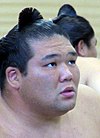 | A traditional Japanese haircut. |
| Comb over |  | Hair that is combed from one part of the head to another often to cover up a bald spot. |
| Cornrows | A hairstyle originating from Ethiopia but popularized by African Americans where the hair is braided into a series of French braid like locks that appear to cling to the head and travel down to the back of the neck. The hairstyle can be worn by both males and females. | |
| Crew cut | 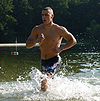 | A hairstyle that is commonplace for many people (especially men) in military units across the western world. |
| Crop | A short hairstyle in which the hair is cut very close to the head, with the hair left long enough to either touch or go past the bangs. Shown here being worn by R&B superstar Rihanna | |
| Croydon facelift | A tight ponytail worn at the top of the head, giving the effect of a facelift. Often inappropriately referred to as a "top knot" (though this term, in its original context, actually refers to a chonmage). Shown here being worn by Actress Sarah Jessica Parker. | |
| Curtained hair | Curtained hair is the term given to the hairstyle featuring a long fringe divided in either a middle parting or a side parting. | |
| Curly hair | Hair that is twisted or wavy. | |
| Devilock |  | The sides and back are kept short, while the front is grown long and combed forward. |
| Dido flip | Hairstyle named after the singer Dido. | |
| Dreadlocks |  | A long hairstyle for either men or women. The hair is dreadlocked into individual sections using one of several methods (usually either backcombing, braiding, hand rolling, or allowing hair to naturally "lock" on its own). The look of dreadlocks can be vary in size, tidiness, and length. Dreadlocks are associated most closely with Rastafarians. |
| Duck's Ass or Ducktail |  | A short men's hairstyle where there is a small long lock of hair at the base of the neck. Shown here being worn by legendary musical superstar Elvis Presley |
| Emo Hair | This tends to have a heavy, often over the eye fringe. this style tends to be varied with long and short sides | |
| Fauxhawk |  | Also known as the frohawk, this hairstyle is an approximation of a mohawk, made without shaving or buzzing the hair on the sides of the head, allowing an imitation of the look of a true mohawk without having to commit to removing most of one's hair. |
| Feathered hair | Feathered hair was a hairstyle popular in the 1970s and the early 1980s with men and women, the hair was grown long on both sides (normally covering the ears, although it could be shoulder length) unlayered (although some men with curly hair did have it layered) with either a side or a centre parting. | |
| Feelers | Often mistaken for sideburns, this is the hair at length from in front of the ears, straightened down while the rest of the head's hair is kept short. | |
| Finger wave |  | |
| Flattop |  | A men's haircut where the hair is cut with a razor but left longer than a buzz cut and appears to be flat on the head. |
| Fofa | ||
| Fontange | A hairdo popular in the second half of the seventeenth century. | |
| French braid | 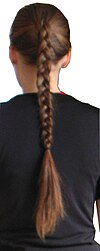 | A French braid is a braid that appears to be braided "into" the hair. Many describe it as making a braid backwards. |
| French twist | 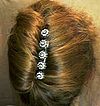 | A hairstyle where the hair is twisted behind the head into a sort of bun style. |
| Half Updo | Popularized in the 1960s by sex icons like Brigitte Bardot, this woman's hairstyle requires medium-length or longer hair. The hair is sectioned from the temples all the way back and then fixed into bun, chignon or ponytail to secure into place (therefore, half the hair is in an updo). If a woman has bangs or a fringe, that area is usually left free and not pulled into the updo. Frequently, the hair at the crown of the head is "teased" or backcombed first to create volume and a bit of disorganization—the effect is considered sexy. | |
| High and tight | A military variant of the buzz cut. | |
| Hime cut | 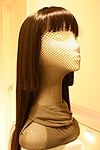 | A hairstyle that consists of long straight hair that goes to at least below the shoulder blades with part of it cut to about shoulder length and bangs that go to the eyebrows. |
| Highlights | Popular among young people in Asia during the late 1990s and early 2000s with long hair. The style involves highlighting or dying various thin strands of hair via hair coloring. | |
| Hi-top fade | ||
| Horseshoe Flattop | ||
| Induction cut | The hair is tied in a pony tail and a razor is used to shave the entire head. This cut is commonly used when a boy turns 10 in Japan. | |
| Jheri curl | Hair that is curly and kept wet by a Jheri curl activator. This style was popular in the 1980s especially with African-Americans. | |
| Japanese hair straightening | ||
| Jewfro |  | A Jewish Afro hairdo that is curly. |
| Khokhol | The Ukrainian name for a style consisting of an entirely shaven head, save for one lock of hair grown on the top or front of the head. Name comes from the Ukrainian Cossacks, among whom the style was common. (See Khokhol article for the word's derogatory usage) | |
| Kudumi or Sikha | The South Indian name for a style consisting of a long tuft, or lock of hair left on top or on the back of the shaven head of a male Orthodox Hindu. | |
| Layered hair | A women's hairstyle where different sections of the front hair are cut at different lengths to give the impression of layers. | |
| Liberty spikes |  | Hair that is grown out long and spiked up usually with a gel |
| Long hair |  | A style of hair that is not cut. |
| Mohawk | 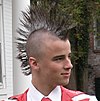 | Hair that is shaved or buzzed on the sides leaving a strip of hair in the middle. It is often spiked up. |
| Mop-Top | A mid-length haircut that has bangs that go over the forehead,collar length in the back, and on the side the ears are partly covered by the hair. Was invented and made popular by The Beatles (John Lennon, Paul McCartney, George Harrison, and Ringo Starr) | |
| Mullet |  | Hair that is short in front and long in the back. |
| Odango | 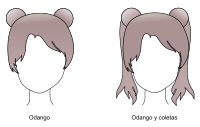 | A hairstyle where two buns are worn on at either side of the head with the rest of the hair worn down like pigtails. |
| Pageboy | A longer version of a bob, typically worn with bangs and below chin length | |
| Part | ||
| Perm | ||
| Pigtails |  | Hair that is parted down the middle and made into two pony tails on either side. |
| Pixie cut |  | A short layered women's hairstyle with a shaggy fringe. |
| Pompadour |  | |
| Ponytail | 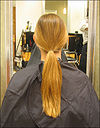 | Hair that is pulled to the back of the head and often held with a hair tie or ribbon. |
| Quiff |  | |
| "The Rachel" | A layered haircut | |
| Razor cut | includes choppy short layers, and thinned by the bottom. Usually like "emo" hair. Usually has a side-sweep fringe. | |
| Recon | A radical version of the High and tight, with the sides and back cleanly shaved very high up the head, intentionally leaving a very extreme contrast between the longer top hair and the shaved sides. | |
| Rattail |  | Hair that is grown out long and shaved or buzzed except for a long, thin braid at the very top of the neck. |
| Ringlet |  | Long hair that is worn in elaborate and tight curls. |
| Shag | A choppy layered hairstyle, characterized by layers to create fullness in the crown and fringes around the edges. There are many versions including the frat shag and boy's shag. | |
| Short back and sides | Also known as a boy's cut, a simple hairstyle with an overall short length. | |
| Shape-Up | ||
| Spiky hair | All hair sticking up, like spikes sticking out from the head. Foundation of popular culture hairstyles in Asia. | |
| Straight hair | Hairstyle that is straight. | |
| Tonsure |  | |
| Undercut | ||
| Updo | An updo is the hairstyle in which the hair is twisted or pulled up. Examples of updos: http://www.beautyriot.com/category.php?id=71 | |
| Waves | Short Hair Waves, shortened to just waves, is a very common and sought after hairstyle for African American men that create the appearance of water like waves of the hair | |
| Wings (haircut)| |
Saturday, July 25, 2009
Thursday, July 23, 2009

Facial Tips
Facial to lighten Dry Skin
Milk contains lactic acid, an AHA. Regular use of milk helps lighten skin gently, leading to fairer skin. Lactic acid may irritate sensitive skin though. Although milk is soothing for most people, you still should test it on the crook of your arm to see if it irritates your skin. If no irritation occurs, then proceed.
Before you star
- Wash your hands with soap and water.
- Wash all the bowls, whisk, utensils, spoons, cups and whatever equipment you will be using for this facial with soap and water. Sterilize these with boiling water. (Note: do not boil glass items as these can crack and the splinters can injure you. Certain plastics can melt if boiled so watch out for that). Make sure all surfaces you use for preparing this facial are clean. Remember. For home facials, hygiene and cleanliness is all important.
- Soak 2 cotton pads in rose water.
- Prepare 3 large sterile strips of cotton wool. The 1st strip should be large enough to cover your neck. The 2nd strip should be able to cover the lower part of your face from below your ears across your face under your nose. The 3rd should cover the rest of your face (Leaving a gap for your nostrils so that you can breathe.) Soak these pads in buttermilk.
- Put a handful of rose petals into a bowl.
- Fill a kettle with water and set that to boil.
- Wear a hair band or shower cap to keep your hair off your face. Get ready some cotton pads and a clean towel an 1 tablespoon of skim milk.
- Now you are ready for your facial.
The facial
- Dip a pair of clean cotton pads into a bowl with 1 tablespoon of milk and 1 teaspoon of almond oil. Use these pads to wipe your makeup off your face. Discard leftover mixture.
- Wash off the milk and oil with lots of water.
- Mix 1 tablespoonful of milk with the almond flour. Use that as a scrub to cleanse your face. Discard leftover scrub.
- Wash off the scrub with lots of water.
- Dry your face with a clean towel.
- Pour boiling water into the bowl of rose petals.
- With the towel forming a 'tent' over your head and the bowl, keep your face about 20cm above the bowl. (Caution: Skip this step if you are an asthmatic. The steam could trigger an attack. Skip this step if you have thread veins. The heat could worsen your condition )
- Relax and let the steam cleanse your face for 10 minutes.
- Put 1 pad soaked with rosewater over each eye
- Soak the 3 large strips of cotton wool in buttermilk. Apply that on your face as a mask, avoiding your nostrils so that you can breathe. Put the strip across your neck first, then the strip under your nose, followed by the largest strip above your nose over the rest of your face. Be sure to leave your nostrils uncovered so that you can breathe easily. Discard leftovers.
- Relax with the mask for 30 minutes.
- Remove the pads and cotton wool.
- Wash off the residue with lots of water.
- Dip 2 new cotton pads in the witch hazel and use it as a toner to clean your face further.
- Apply your favorite moisturizer and you are set to go.









